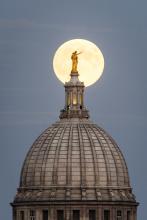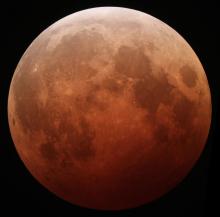Listen to today's episode of StarDate on the web the same day it airs in high-quality streaming audio without any extra ads or announcements. Choose a $8 one-month pass, or listen every day for a year for just $30.
You are here
Daytime Moon
The Moon is the most dominant object in the night sky. It outshines every star and planet, even when it’s a barely-there crescent. Yet the Moon isn’t limited to the night. It spends just as much time in the daytime sky. Most of us don’t notice it, though, because it’s a poor second place to the Sun.
To be fair, the Moon is never at its best when it’s in the sky at the same time as the Sun. It shines brightest when it’s full. At that moment, though, it lines up opposite the Sun. So the full Moon is just rising as the Sun sets, and just setting as the Sun rises.
And for a couple of days before and after it’s full, the Moon shares the sky with the Sun for only a little while — just before sunrise or after sunset. And for a day or two on either side of its new phase, it’s not really visible at all — during day or night.
For every phase between those extremes, though, the Moon can spend hours in the daytime sky. But the Sun can be millions of times brighter, so it fills the sky with light. Through the curtain of blue sky, the Moon looks washed out — a mere shadow of its nighttime glory. If you find it, though, it’s still a beautiful sight.
As the Sun rises tomorrow, for example, the Moon will stand in the south, with sunlight illuminating about a third of its visible hemisphere. It’ll arc low across the south and southwest during the morning, and set in the early afternoon — the champion of the night in the daytime sky.
More tomorrow.
Script by Damond Benningfield





